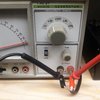Yup.I suppose......not disagreeing with you or anything but was just curious. Really you are ball parking it but since there are a couple variables to deal with such as mike gain and internal adjustments then ball parking is close enough since the user operator will be able to adjust it anyway. The important thing is to set the max modulation limit properly and ensure that it cannot be exceeded by advancing the mike gain on the front panel too far.
And if we were to be totally honest about scope use, we also both know that gauging 30% modulation is also ball parking it. I mean; how many of us use a gauge on the scope screen and measure? Not I. But we can see distortion and cannot count it in as part total % of modulation. That's recognizable, and also a trap for new players. But voltage/amperage/freq settings; those are easily more definable.



